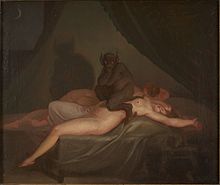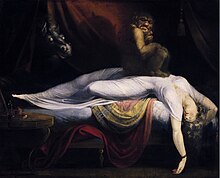Night alb


Nachtalb is a late name for a fantasy and legendary creature that was originally called "Mahr" and weighs on people at night (see nightmare ) and gives them horror .
It is usually a small, black creature that attacks sleeping people and pets, and rarely things too. It penetrates through keyholes or knotholes. The attack is associated with anxiety and shortness of breath .
In some stories, the Mahr has a clearly erotic character. There are reports of sexual intercourse between humans and Mahr. Together with the werewolf, he is one of the solitary creatures who can change their shape. Age brings disease, and in some parts of Scandinavia the boundaries between witches , creatures that steal mother's milk, revenants and ghosts are fluid. The motif is pre-Christian and international.
According to the texts of old Scandinavian literature, these are people who can shift their " hugr " into another shape. "Hugr" is more than the soul in the Christian sense, it is the entire non-corporeal being of the human being, including his thoughts and desires.
A close relationship to the nature of Odin can be established. Snorri says of Odin:
"Óðinn skipti hömum. Lá þá búkurinn sem sofinn eða lastur en hann var þá fugl eða dýr, fiskur eða ormur og fór á einni svipstund á fjarlæg lönd að sínum erindum eða annarra manna. "
“If Odin wanted to change his shape, then his body lay there as if asleep or dead, but he himself was a bird, a wild animal, a fish or a snake. He could go to distant lands in a moment for his own business or other. "
In contrast to witches and other wizards, the Nordic mahr is always associated with "riding" and inflicting damage at dusk or at night. Other spirits never ride. In the old Norwegian Christian law , riding as a mahr is expressly made a punishable offense. "If it is proven that a woman rides a man or his housemates ..." it says in § 46 of the Christian law of the Eidsivathing. The possibility of changing shape as Mahr and performing a Mahr ride is presented as a real possibility.
The Eyrbyggja saga from the middle of the 13th century is about the jealousy of the two women Geirrid and Katla, whereby Geirrid is then accused in a process of having acted as Mahr. Likewise, in the Ynglinga saga, Vanlandi's death is attributed to a Mahr who was hounded at him by his abandoned wife in Finland, who was just in Uppsala.
"Þá gerðist honum svefnhöfugt og lagðist hann til svefns. En er hann hafði lítt sofnað kallaði hann og sagði að mara trað hann. Menn hans fóru til og vildu hjálpa honum en er þeir tóku uppi til Höfuðsins þá trað hún fótleggina svo að nær brotnuðu. Þá tóku þeir til fótanna. Þá kafði hún Höfuðið svo að þar dó hann. "
“Then he got sleepy and lay down to sleep. But when he had just slept a little, he cried out and said that he was kicking a mile. Then his people came over and wanted to help him. But when they grabbed him by the head, she stepped on his legs that they almost broke. They now grabbed his feet, but the mare now pressed so on his head that he had to die there. "
In the Middle Ages the mythical creature lived on in the form of various superstitions , and it was counted among the black mountain spirits , dwarves and night elves .
In Low German legends, the mostly female mahr takes on the functions of the night mahr, but hardly resembles its shape.
Also the " Schrätteli " or "Schrättele" from many legends of the Black Forest is probably a modification of the Nachtmahr. Again, it is mostly a female or even a witch who leaves her body and enters the bedroom of her victim through the keyhole in the form of a straw. Once there, she plagues and “presses” her victims until they are completely exhausted. The Schrätteli is also said to often “push” the cattle in the barn in order to get relief when they cannot “push” people.
Later the night alb was also equated with the devil : the phrase "The devil rode you" is to be understood as a synonym for "You rode the night alb".
Similar to Frau Holle , who is supposed to dishevel web and hair , it was also said of the night alb that to knot open hair in humans and animals. That is why the Nachtalb was also called “Alpzopf”, “Drudenzopf”, “Wichtelzopf” and “ Weichselzopf ”.
Between the 13th and 14th centuries, a distinction was made in France between male ( incubus = trailer) and female ( succubus = lower) night albums , which were said to have magical seduction skills. In 1318 this was expressly confirmed in a witch trial at the Sorbonne (Paris).
The word “Mahr” comes from the Germanic root “mer”, which means “pound”, Old High German, Old and New Swedish, Polish, Icelandic “mara”, Middle Low German, Middle High German, Anglo-Saxon, Norwegian “mare”, Czech “můra”, Slovak "mora", Wendish "murawa", in English in "nightmare" and in Russian in "кошмар" (from the French from "cauchemar"). After the Reformation, the word was replaced by “Alp” or “Alb” without changing its content. The warlord “morrigain” found in Irish mythology is also etymologically related to “mara”.
Ivar Leon Menger freely addresses the nightmare in his audio book trilogy Monster 1983 from 2015, but with many references to the traditions.
literature
- Woldemar Cubasch: The Alp . Habel, Berlin 1877
- L. Petzold: Mahr (t). In: Reallexikon der Germanischen Altertumskunde (RGA). 2nd Edition. Volume 19, Walter de Gruyter, Berlin / New York 2001, ISBN 3-11-017163-5 , pp. 175-176.
- Catharina Raudvere: … mara trað hann. Maragestaltens förutsettningar i nordiska förkristna själsförestillingar. In: Nordisk Hedendom. Et symposium. Odense 1991. pp. 87-102.
- Moritz H. Strahl: The Alp. Its essence and its healing . Enslin, Berlin 1833
- Carl-Herman Tilhagen: Mara . In: Kulturhistorisk leksikon for nordisk middelalder . Volume 11, Copenhagen 1966, Col. 343-345.
- Johannes Künzig: "Schwarzwald-Sagen", Eugen Diederichs Verlag, 1976, pp. 4-6.
- Ivar Leon Menger: Monster 1983, Audible 2015-2017
